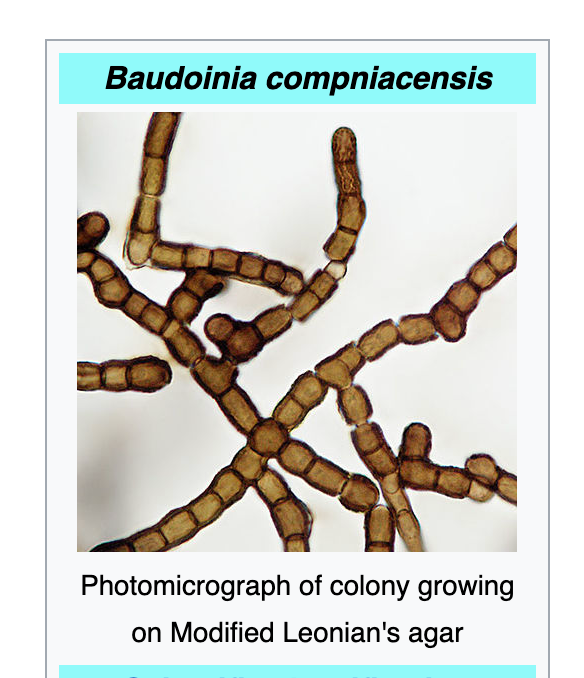"Whiskey Fungus" words
« previous post | next post »
Today I learned about "whiskey fungus" — and the linked page will tell you all about it, from a general perspective, including the nature and role of the "angel's share". But I also clicked on the Wikipedia article for the fungus species involved, Baudoinia compniacensis, and the first paragraph of that article's Description section featured an unusually large number of technical terms previous unknown to me.
I've put the new (to me) vocabulary items in boldface:
Baudoinia compniacensis can be identified by its black, effused mycelium that can be velvety or crust-like. It features hyphae which are vegetative, dark brown, thick-walled, and often moniliform; although it lacks distinctive conidiophores. Conidiogenous cells can be found integrated within vegetative hyphae. Its conidia are dry, nonseptate or uniseptate, at the median. The conidia are thick-walled, globose to barrel-shaped, brown to black, and typically found with coarse surface ornamentation, dehiscing by schizolysis. Ramoconidia are absent. Colonies on MLA grow slowly and are dark in pigmentation. Synanamorphs are absent during its asexual reproduction stages. The presence of teleomorphs is unknown.
There are some other Latin or Greek compounds in the paragraph whose parts I know and therefore whose meaning I can guess, e.g. nonseptate and uniseptate. Many of the others involve conidia, plural of conidium — sometimes in compounds whose other parts are well known, e.g. conidiogenous, while others can be found in Wikipedia, dictionaries and elsewhere.
But I'm left puzzled by the phrase "colonies on MLA". I assume that in this context, "MLA" is not a reference to the Modern Language Association. Wikipedia's MLA disambiguation page doesn't help me — "Mandated Lead Arranger"? "Massachusetts Lobstermen's Association"? "Meat and Livestock Australia"? "Montessori Lyceum Amsterdam"? Nah, I don't think so.
No doubt a fungally-informed commenter can explain this one to us.
Update — it's apparently "Modified Lionian's agar", as a picture on the same Wikipedia page suggests:
Details can be found here, including a recipe:


ycx said,
August 22, 2022 @ 9:01 am
MLA is Modified Leonian's agar (a hydrogel nutrient medium on which fungus can be cultivated)
Dick Margulis said,
August 22, 2022 @ 9:01 am
Maintenance of lipid asymmetry. No, I didn't know that. Google helped.
Dick Margulis said,
August 22, 2022 @ 9:01 am
Or not.
MattF said,
August 22, 2022 @ 10:10 am
People who are suing the distilleries to force a fungus cleanup might consider that the fungus is occupying an ecological niche— if you eliminate the current niche inhabitant it could well be replaced with something worse.
Joe said,
August 22, 2022 @ 10:12 am
This is a weird case in which translating the paragraph to Simple English Wikipedia would probably just mean deleting most of it. The syntax is actually very simple and straightforward; it's just full of esoteric jargon. That jargon generally needs to be there, because it's not unnecessarily fancy verbiage beating the bush around simple concepts but rather standard and necessary terms for obscure concepts. It should certainly make better use of hyperlinking (I guess the mycologists who wrote it assumed that even laypeople know what mycelium is), and obviously "MLA" should have been spelled out, and the four sentences about the conidium situation suggest an opportunity to tie those relationships together with common words instead of using four related jargon terms. But it's hard to imagine writing this paragraph in a way that's comprehensible to laypeople without making it less informative to experts, the sacrifice that Simple English Wikipedia is willing to make but the regular English version is usually not.
Heino said,
August 22, 2022 @ 8:04 pm
It would be possible to rewrite this for a lay audience, after three basic bits of jargon have been defined. Those three are hypha, mycelium and conidium. A mycelium is composed of a mass of hyphae, each hypha being a filament that grows in length and branches, with each branch extending and branching again and so on. A conidium is an asexual spore (i.e. one where no genetic mixing from two parents is involved). Now, carry out the following replacements: conidiophore (conidium-bearing hypha), conidiogenous (conidium-producing), ramoconidia are absent (sections of conidium-bearing hyphae do not break off and act as conidia), moniliform (with swellings at regular intervals), dehiscing by schizolysis (liberates by the splitting of the cross-wall between the conidium and the conidium-producing cell). MLA has already been explained and the final two sentences I would rewrite as: A sexual state (in which spores are produced via mixing of genes from two parents) is not known and no other form of conidium production is present. It would also be necessary to re-order the text slightly.
Of course, the rewritten text would annoy at least some mycologists (even though it is no less informative) – but it is a question of the intended audience.
Many fungi have both a sexual state (in which spores with a genetic mix from two parents are produced) and one or more asexual states (in which spores do not contain a genetic mix). The sexual state is the teleomorph, so called because it was once supposed that this was the ultimate, perfect form that any self-respecting fungus would aim for. Anamorph is the term for an asexual state and if a particular fungus has two or more distinct asexual states each is one of the synanamorphs of that fungus.
Rick Rubenstein said,
August 22, 2022 @ 11:57 pm
Henceforth it shall be known as Mark Liberman's Agar.
AG said,
August 24, 2022 @ 2:17 am
I very recently learned "dehiscing" when reading about the history of wheat.
It seemed counterintuitive on first read-through, but we artificially selected wheat to be more difficult to dehisc, er, separate from the stem (so we could carry it home from the field without losing it all)